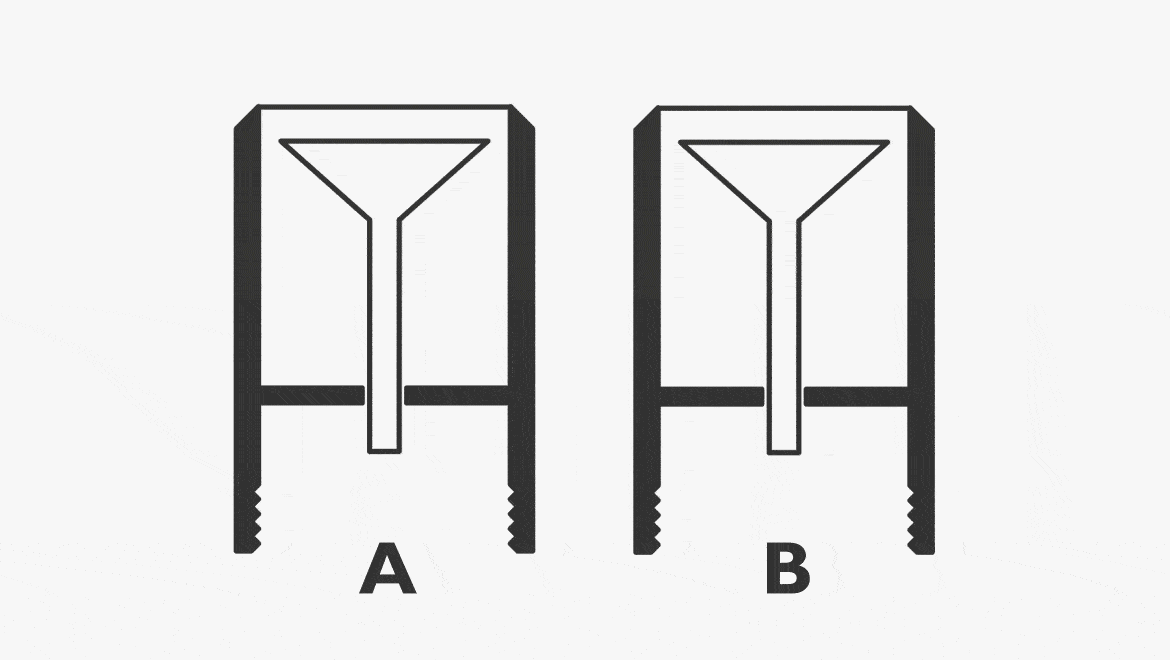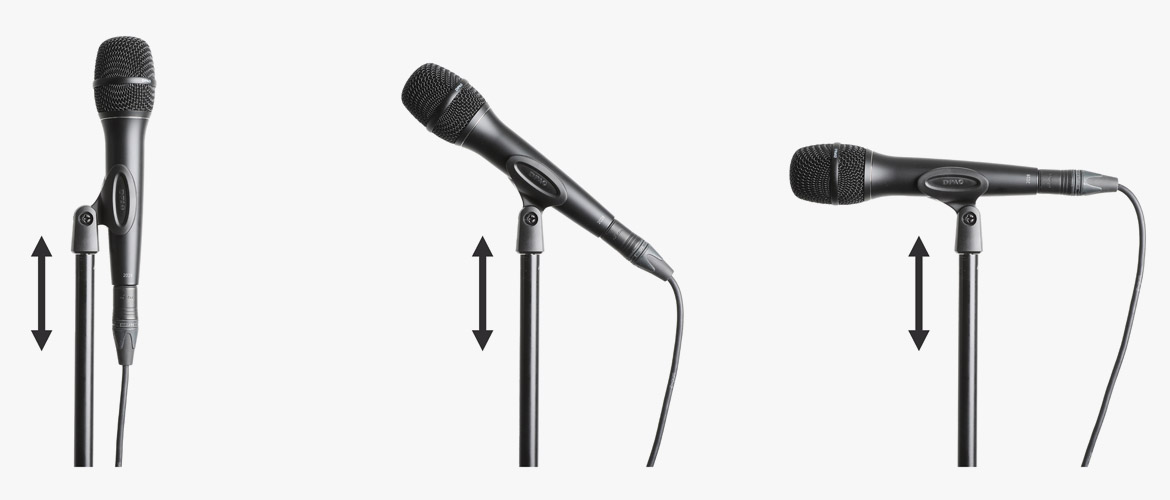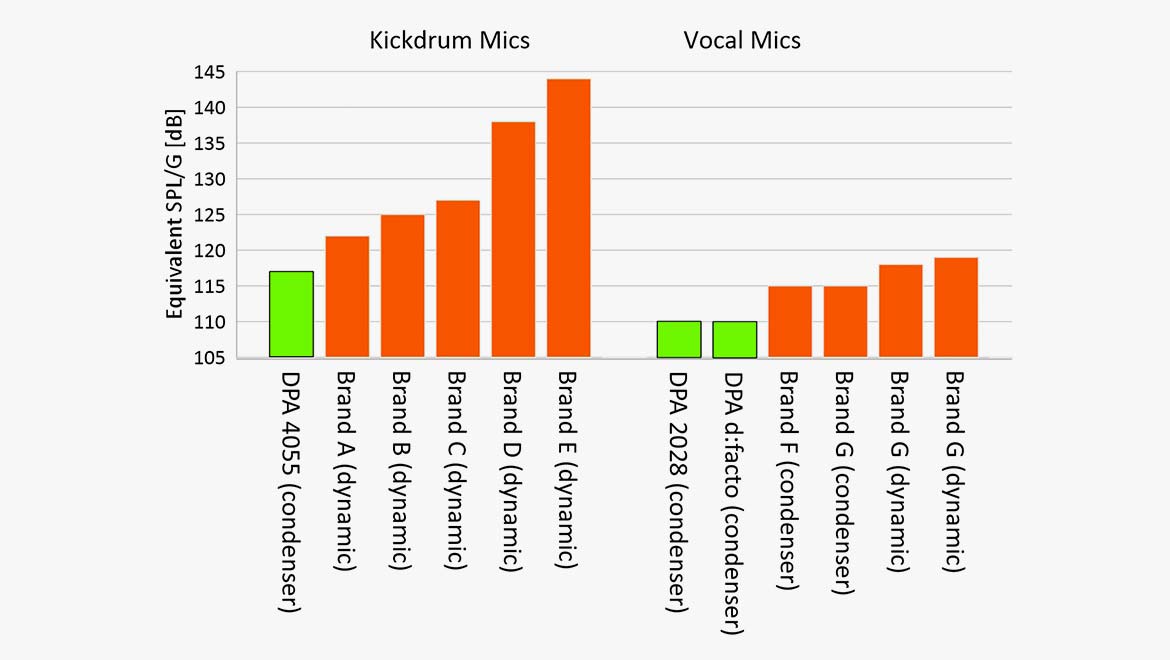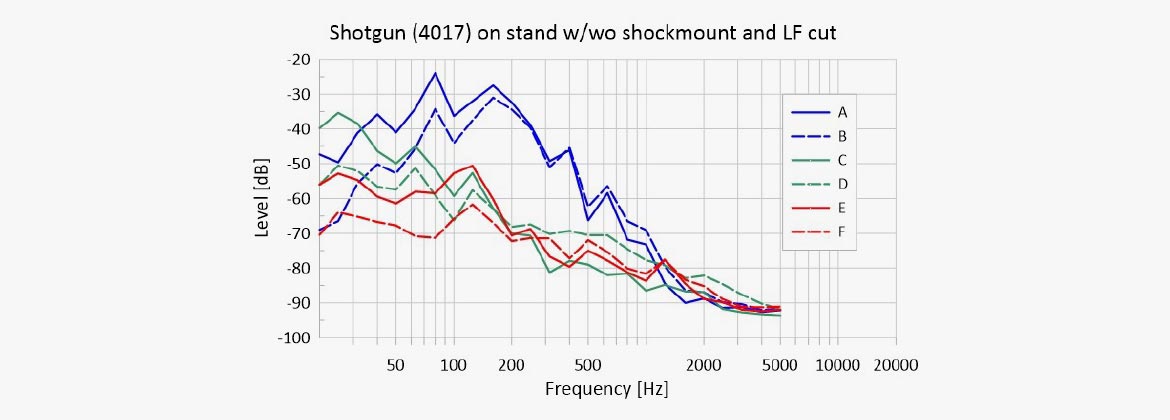A microphone should only react to acoustically transferred sound. However, unfortunately, most mics also pick up vibrations that generate unintentional output. This can create undesirable effects like low-frequency feeds, partial timbre shifts of musical instruments, metallic sounds, and so on. In this article, we look at the phenomenon and discover its seriousness.
The mic drop
It happens. An accidental mic drop. A big bang in the PA system. This is actually not the sound of the mic hitting the floor – it is because the shock made the transducer generate a signal.
A microphone’s diaphragm is designed to move only when the air around it vibrates; this is usually the case when keeping the microphone in a fixed position. However, imagine the microphone housing being shaken. The diaphragm is relatively reluctant to move due to mass, air resistance and mechanical compliance; so, the housing moving more than the diaphragm also generates an output. See figure 1.

Figure 1. A: diaphragm vibrates due to acoustic sound. B: housing vibrates due to transferred mechanical excitations: Both cases create an output signal.
The vibration problem is mainly related to microphones mounted on a stand or a holder/clip, for instance, on a musical instrument. In the case of handheld microphones, improper hand rubbing of the housing or finger ring clicking may cause unwanted sounds. (See: How to avoid handling noise). Also, placing the handheld microphone in its holder/clip may generate an impulse when it snaps. Otherwise, the arm and hand are fine filters for reducing external vibrations.

Figure 2. In principle, a condenser microphone consists of a mass (the diaphragm), a spring (the diaphragm tension), and system damping (the elastic suspension of the diaphragm). On top of that, the whole capsule may be suspended to achieve some form of isolation from the housing.
Vibration – where and how much
Vibrations are present everywhere. However, there are certain places where the vibration levels are stronger than others.
Stage floor
A good stage floor is solid and does not produce much vibration. However, some stages – floors or risers – for use with classical string instruments like the cello and double bass must provide good support for these instruments. They may vibrate slightly depending on excitation (steps on stage, sub-woofers, coupling to the PA, etc.).
A bad stage floor or drum riser can vibrate easily at low frequencies. Many floors or podiums exhibit a vibrational level of 1 G if subwoofers are below or a drum kit is on top. (G is a unit for acceleration. 1 G ≈ 10 m/s2).
The mic stand may or may not be isolated from the floor. However, hitting the mic stand with an instrument or stomping on the floor still produces vibration levels above 1G.
Drums
When hitting a drum, the whole kettle vibrates. For example, when hitting the rim of a snare or tom with the drumstick, the vibrational level may exceed 20G(!) on these drums that often use clip-on mics. Power-hitting other drums, especially the kick drum, may create similar levels!
String instruments
These instruments have a body that supports the vibrating strings. Most string instruments, especially the double bass and cello, also have a so-called wolf tone. Here the resonance becomes so strong that it counteracts the played note. This resonance, as well as others, may affect a microphone mounted on the instrument. The suspension of that microphone may determine how well it records the sound.
Brass
The Schallstück or bell vibrates to some degree, though not necessarily an extreme amount. However, resonance may become a problem with a small non-dampened clip-on mic.
How microphones respond to vibrations
It is practical to know how sensitive a microphone is to these vibrations. To find out, we collected some mics and experimented:
Each mic was mounted on top of a shaker (see figure 3), and they were fixated to the shaker using the supplied clip or holder.
A broadband signal (pink noise) was fed to the amplifier driving the shaker. (No acoustic sound was present). The mic output and the forced acceleration (picked up by an accelerometer) were recorded, providing data for the transfer function and the mic’s sensitivity to vibrations.
 Figure 3. Setup for testing vibration-generated output from microphones.
Figure 3. Setup for testing vibration-generated output from microphones.
Directionality dependent sensitivity
By nature, most microphones are sensitive to vibrations in a direction perpendicular to the membrane, which, in the case of pencil microphones, is the on-axis direction. Therefore, we applied on-axis excitation in this test, supplemented by excitation angles of 45° and 90° (by turning the clip, see figure 4).
 Figure 4. Three directions of excitation: 0° (on-axis), 45°, and 90°.
Figure 4. Three directions of excitation: 0° (on-axis), 45°, and 90°.
Equivalent SPL per G
When measuring the output of a vibrated microphone, it is possible to describe an equivalent SPL that will produce the same signal out of the microphone as the vibration now does. This level is typically in the range of 75-125 dB SPL/G. Meaning: Vibrating the microphone at 1 G yields a signal with the same magnitude as that a sound source with an SPL of 75-125 dB SPL would generate. In fact, when shaken, some microphones may produce even higher output than that.
The microphones measured included condenser as well as dynamic types. The example diagrams below show the transfer function in three different directions. Thus, each diagram contains three curves for each microphone: Black: 0° on-axis excitation, blue: 45° excitation and red: 90° excitation. In all cases, the 0° angle is perpendicular to the membrane.
All measurement setups utilize the holder or clip included with the specific mic.
Kick drum mics

|
Name:
Type:
Application:
Equiv. SPL:
|
DPA 4055
Condenser mic
Kick drum mic
117 dB SPL/G @ 315 Hz, 0°
|
Name:
Type:
Application:
Equiv. SPL:
|
X Brand
Dynamic mic
Kick drum mic
144 dB SPL/G @ 43 Hz, 0°
|
Figure 5. The transfer function of two kick drum mics. The Equivalent SPL/G is measured by exiting the microphone at one single frequency (and direction) where the highest output occurs.
Vocal mics

|
Name:
Type:
Application:
Equiv. SPL:
|
DPA 2028
Condenser mic
Handheld
109 dB SPL/G @ 200 Hz, 0°
|
Name:
Type:
Application:
Equiv. SPL:
|
X Brand
Dynamic mic
Handheld
118 dB SPL/G @ 200 Hz, 0°
|
Figure 6. The transfer function of two vocal mics. The Equivalent SPL/G is measured by exiting the microphone at one single frequency (and direction) where the highest output occurs.

Figure 7. Equivalent SPL/G of six popular kick drum mics, one of which is the DPA 4055. Also, six popular vocal mics (both condenser and dynamic microphones), of which two are DPA condensers: 2028 and d:facto™. The Equivalent SPL/G is measured by exiting the microphone at one single frequency (and direction) where the highest output occurs. The lower the Equivalent SPL/G, the better. Note that in a drum kit, the vibrational level may exceed 1G by more than 20 dB.
De-coupling vibrations
If you want to get rid of microphone vibrations, use a high-quality shock mount. Shock mounts are available for most pencil microphones but not necessarily for mics with conical housings, like handheld mics. This makes vocal microphones on stands vulnerable to a vibrating stage floor. However, when placed on a stand, the mounting angle is usually not 0° but rather 90°, and microphones are generally less sensitive in that direction. Further, by design, many handheld microphones dampen the effect of vibrations.
Most problems occur when mounting mics on a drum kit. First, there are multiple directions of excitation, not just one. More directions come into play, depending on the part of the kit being hit. This makes shock mounts more or less obligatory for a kick drum. However, many mounting tools do not provide sufficient damping. So, it is of interest how mics behave under these conditions.
The graph below shows the effect of shock mounts. It shows a 4017 Shotgun Microphone mounted in a clip, in a standard shock mount and in a dedicated shock mount made for shotguns. The B amplifier with the 4017 Shotgun Microphone contains a lowcut filter, which is off/on with each holder.
The vibration is generated by kicking one of the legs on the three-legged stand. You can listen to the recording here. (See: 10 important facts about acoustics for microphone users).

Figure 8: Vibration generated signal by kicking a mike stand:
A: Mic in a standard clip (UA0639). No low cut applied.
B: In a standard clip. Low cut applied.
C: In a shock mount (UA0897). No low cut applied.
D: In a shock mount (UA0897). Low cut applied.
E: In a dedicated shock mount. No low cut applied.
F: In a dedicated shock mount. Low cut applied.
The curves show, in one case, that the low-frequency vibration (20-30 Hz) increases when using a shock mount originally designed for heavier microphones. The resonance of the system comes into play. (In this case, it helps to apply the low cut.)
Can it be specified?
There is an international standard for specifying or documenting microphones - IEC 60.268-4. Most microphone manufacturers follow the standard, including DPA Microphones. This standard has a paragraph (§19.2) on this topic: “Equivalent sound pressure due to mechanical vibration”.
The measurements in this article followed the principles in the IEC guidelines. Please note that most manufacturers keep this data to themselves – if it is even measured at all.
Conclusion
Microphone output can be created in at least two ways*): One is the signal originating from the acoustic sound and the other is the signal produced by vibrations. These two different sources sound quite different. The vibrational source is resonant and colored. Also, the phase relation between the two outputs may come into play – the mix may suffer if the vibration-generated sound reaches a level comparable to the acoustic sound. (This is easily achieved in a drum kit.) It is important to select microphones with low sensitivity to vibrations and/or use a high-quality shock mount whenever possible.
*) EMC/RFI may also create unintended output.
References
Burkhard, Mahlon D.: Protection against shock and vibration. Preprint 396, AES annual meeting 17, 1965.
G.R.A.S. application note: 147AX Microphone Vibration Sensitivity. 806-147AX Vibration Sensitivity.pdf (grasacoustics.com)
IEC 60268-4 Sound System Equipment – Part 4: Microphones.
Locke, Terry R: An Effective Mechanopneumatic Shock Mount for Dynamic Microphone. Journal of the Audio Engineering Society, September 1978, Vol 26, No 9.
Plice, Gerald W.: Microphone Accessory Shock Mount for Stand or Boom Use. Journal of the Audio Engineering Society, February 1971, Vol 19, No 2.
Sorbothane Reduces Vibration in Microphones for Hook Studios. Sorbothane® Reduces Vibration in Microphones
Rule, Eric, Suellentrop, Fred j., and Perls, Thomas A.: Vibration Sensitivity of Condenser Microphones. The Journal of the Acoustical Society of America 32, 923 (1960).
Stehle, Charles Douglas: Vibration isolation of a microphone. The Journal of the Acoustical Society of America 80, 699 (1986).
Walsh, Jonathan D.; Su, Quang T.: Characterization of the vibration response of miniature microphones by subtraction. The Journal of the Acoustical Society of America 141, 3677 (2017).
Walsh, Jonathan D.; Miles, Ronald: Microphone length and its effect on vibration interference. The Journal of the Acoustical Society of America 148, 2640 (2020).